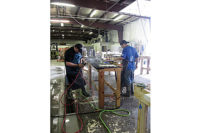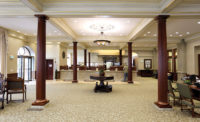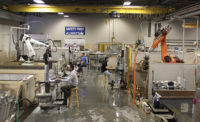For 15 years, Paul Getz was a tile installer. On one of his projects, Getz subbed out the fabrication work for a countertop and installed it himself. This trend of installing countertops continued for a while before Getz decided to open up his own countertop fabrication business. “I was hand fabricating some small pieces,” said Getz. “It is hard to find people who have the ability to do it well by hand. Then if we were down a guy, we all had to work full board to get the work done.” This was how Getz’s shop, Superior Granite, in Mankato, MN, got its start.
At the time, Getz was working 18 hours a day and couldn’t find workers to do everything he needed. “There was a guy in Iowa that was selling a router, a Park [Industries] Destiny,” he said. “To be honest, I didn’t know the first thing about a router. As I was watching it run, I realized that I had been doing it so hard for the past few years. After purchasing that router, I started to do research on lasers. I wanted to learn everything I could about going digital and how I could make it work for my shop. At the time, I didn’t know if I really needed a laser because the system we were doing was fine. I eventually called Laser Products and they showed me how to digitize on the machine. I knew that wouldn’t speed me up enough. So I went out of my comfort zone and got a laser and a plotter. I use that plotter to this day to double check all our work.”
After purchasing the Laser Products LT-55, Getz decided to go all in with digital. He eventually invested in a Park Industries Voyager XP 5-axis CNC stoneworking center, Slab Maker Lite from Slabsmith and a Sasso Flying Flat edge polishing machine. The transition happened quickly. It all came together over the past three and a half years. “We had a good system going when we had to manually cut everything,” said Getz. “Now with Slabsmith and the automated saw, things have really changed for the better. In my opinion, every time you buy a machine it takes 30 days to get a new operation running. The CNC saw changed everything for us so dramatically. We can cut 10 kitchens a day if we wanted to. It’s interesting, us being a small shop, we have people come in and look at our slabs, but most of the people are just interested in watching the machines run.”
The average kitchen in the Mankato area is 52 square feet — every project running into two slabs. Getz explained that he still runs a small crew of five people, but he runs it efficiently. “Everyone here does a little bit of everything,” he said. “I am still on every install job. I like to see the end product so there are no surprises. I have two guys running both machines because of the loading and unloading, while I do the office work. Our one worker, Jordan, will hand polish on occasion with the guys down there. Another worker, Jessie still does hand polishing and machine maintenance. When we go on an install, it’s four of us that go out there, but before we leave, we set the machines up so we can leave a man behind to cut.”
Getz decided on mostly Park Industries machines because of the proximity of its facility. “It’s nice having a machinery company so close by,” said Getz. “If I have a part I need, I can make the drive if necessary. It’s about an hour and a half away. We have enjoyed their machines, and because of them, we have been able to do more commercial work. For example, we just did a bunch of work at North Dakota State University. We wouldn’t have been able to produce all that work without having these machines. Right now, we are doing two kitchens a day start to finish. Then finishing up with hand work. Going digital is a big step with a huge learning curve that can seem daunting. With that being said, going digital increased our efficiency exponentially and has opened our shop up to more opportunities; especially in the commercial markets.”
As far as tooling, Getz uses Terminator blades and ADI tooling from GranQuartz. “The guys from GranQuartz have been a big help,” he said. “Kevin has come in and been honest with me, pushed me in the right direction with tooling and pods and carts. It has been really great for us.”
As far as what material Getz is seeing cut the most, quartz has been popular. “Right now, I seem to be running quartz more than anything,” said Getz. “Once someone has their heart set on something, such as quartz, it’s hard to get them away from it. I am still a big granite guy. It’s the way I have always been. I enjoy working with it. But also right now in the commercial industry, it seems like a lot of quartz is being used.”
|
Moving forward from here We asked Getz what his plans are after he has now made the transition to digital. His response: “Right now, I am really bad at buying something unless I have cash on hand to pay for it. So, my main objective is to get this Voyager paid off. I also have a lease on the shop I am currently at and in the next three years I want to build a brand new shop and get a new router. I hope to upgrade the Destiny to a router that can handle more. Past the next three years though, I haven’t thought about it much. Hopefully be able to ease my workload a little bit.” |
|
Superior Granite Mankato, MNType of work: Residential and Commercial Machinery: a Destiny router and Voyager XP 5-axis CNC stoneworking center – both from Park Industries of St. Cloud, MN; a LT-55 Laser Templator from Laser Products Industries of Romeoville, IL; Terminator blades from Terminator in San Carlos, CA; ADI Tooling from GranQuartz in Norcross, GA; a Slabsmith Slab Maker Lite from Norwood Designs, Inc. in Antwerp, NY; and a Flying Flat edge polishing machine from Sasso USA in Palatine, IL Number of Employees: 5 Production Rate: Two kitchens a day averaging 53 square feet. |












